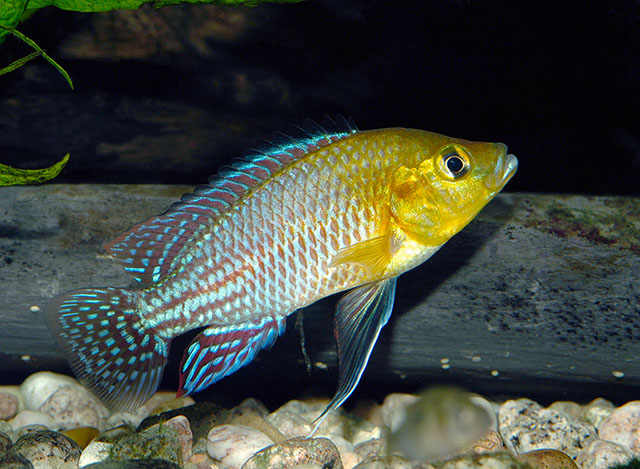| Cichlidae (Cichlids), subfamily: Pseudocrenilabrinae |
| 8.5 cm SL (male/unsexed) |
|
demersal; freshwater; pH range: 6 - 8; dH range: 9 - 19, |
| Africa: from around Yangambi (middle Congo River basin) (Ref. 42033) up to the Upemba lakes (upper Congo River basin) (Ref. 5682, 45434) in Democratic Republic of the Congo. |
|
Description: moderately deep-bodied, especially in old males; frontal profile straight to slightly concave; caudal fin rounded; rays in dorsal, anal and pelvic fins of males often much more elongated than those of females and those of congeners (Ref. 52307).
Coloration: juveniles and females: body grayish to brownish, often with 2, usually broken, longitudinal stripes on body, along with a black bar running from eye to corner of mouth; when stressed, several dusky bars may become visible, running from dorsum to about midbody (Ref. 52307). Adult males: head dark bronze; lower lips and parts of cheeks metallic blue; body blue with rows of red dots that are usually connected to form 3 red lines in posteriormost third of body and caudal peduncle; dorsal fin red with broad black margin in anterior (spiny) parts, blue dots and lines in soft portion; caudal fin dark red with many blue maculae and short lines; outer edge of anal fin deep red, rest of fin reddish with blue lines and dots; pelvic fin rays much more elongated that those of its congeners, dark red to dusky with a pale blue anterior edge; females do not possess any of the aforementioned coloration (Ref. 52307). |
| Ovophilic, agamous maternal mouthbrooder; no pair-bonding takes place (Ref. 52307). |
|
Least Concern (LC); Date assessed: 16 February 2009 Ref. (130435)
|
| harmless |
Source and more info: www.fishbase.org. For personal, classroom, and other internal use only. Not for publication.

